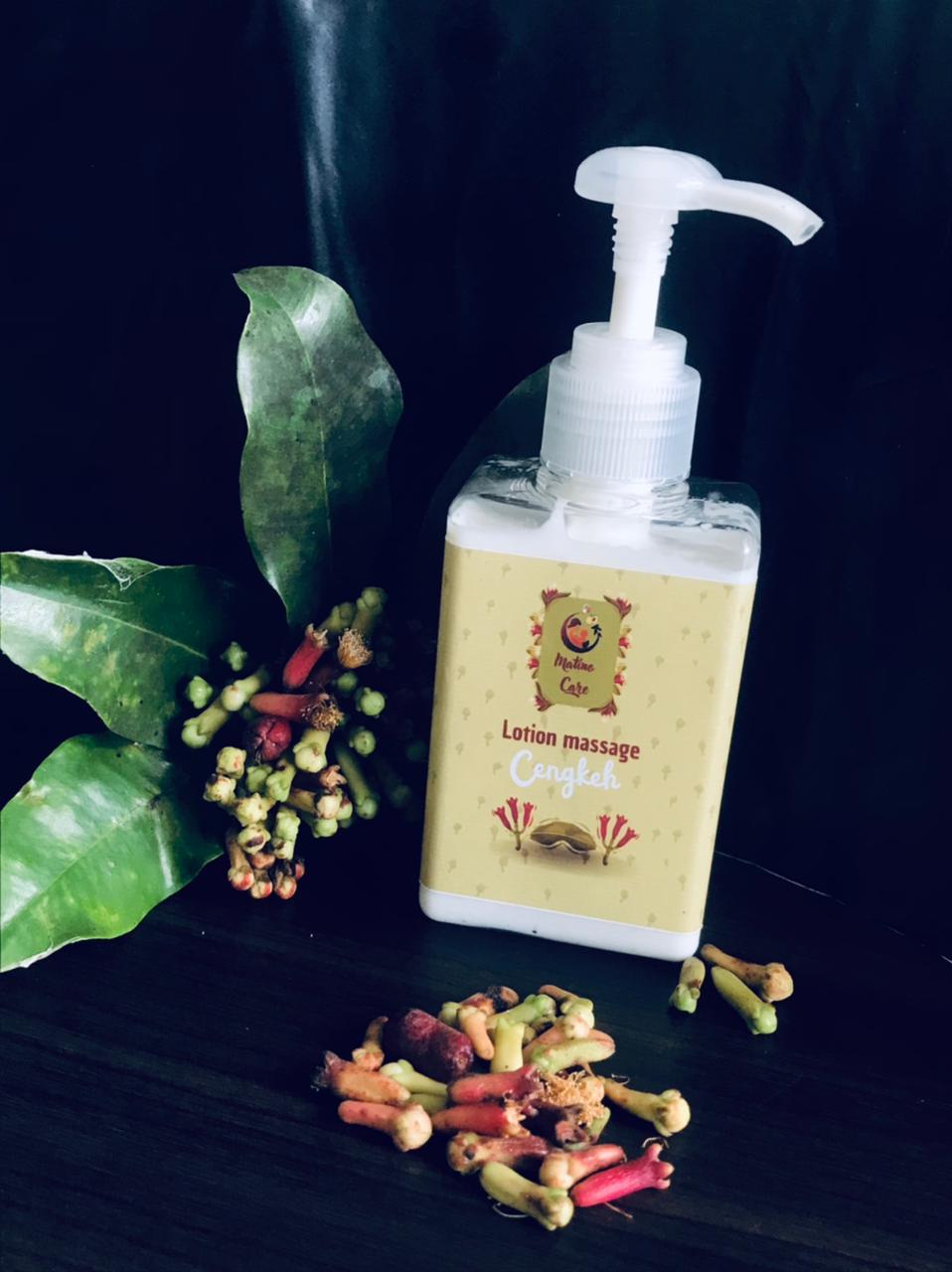Abstract
Postpartum fatigue can be addressed through pharmacological and non-pharmacological/traditional approaches. One common non-pharmacological intervention is light physical exercise such as swimming, aerobics, yoga, cycling, and massage. Massage is a form of traditional medicine that has been passed down through generations and is believed to have health benefits, including improving sleep quality and body relaxation. Massage with the right technique is believed to improve overall health. In its implementation, massage often uses lotions, oils, or balms as lubricants to facilitate movement. Clove oil, extracted from the Syzygium aromaticum plant native to Maluku, Indonesia, has analgesic properties that have been shown to relieve postpartum musculoskeletal pain. Furthermore, the aroma produced by clove oil has the potential to provide a relaxing effect and reduce stress levels in mothers. This research aims to develop a clove oil-based lotion formulation that will be used in massage practice. The research design used is a clinical trial consisting of several stages. These stages include obtaining ethical approval, permits from Kesbangpol (Ministry of Home Affairs), laboratory permits, and finally the lotion formulation process. The evaluation of the clove oil lotion preparation formula D for postpartum massage involved testing viscosity, pH, organoleptic properties, homogeneity, spreadability, and adhesion. The results showed that the lotion was white in color with a distinctive clove aroma, had a viscosity of 5620 cps which was in accordance with standards, a pH of 5.96 which met SNI standards, a good spreadability value of 6.9 cm, and a very good adhesion value of 4.37 seconds. The sensitivity test also showed negative results, which means the lotion did not cause irritation. Based on these test results, it can be concluded that the clove oil lotion preparation formula D was successfully formulated after four trials.
References
Brito, A. P. A., Caldeira, C. F., & Salvetti, M. D. G. (2021). Prevalence, Characteristics, and Impact of Pain During The Postpartum Period. Revista da Escola de Enfermagem, 55, 1–7. https://doi.org/10.1590/S1980-220X2019023303691
Deussen, A. R., Ashwood, P., Martis, R., Stewart, F., & Grzeskowiak, L. E. (2020). Relief of pain due to uterine cramping/involution after birth. Cochrane Database of Systematic Reviews, 2020(10). https://doi.org/10.1002/14651858.CD004908.pub3
Dominica, D., & Handayani, D. (2019). Formulasi dan Evaluasi Sediaan Lotion dari Ekstrak Daun Lengkeng (Dimocarpus Longan) sebagai Antioksidan. Jurnal Farmasi Dan Ilmu Kefarmasian Indonesia, 6(1), 1. https://doi.org/10.20473/jfiki.v6i12019.1-7
Hafif, M. (2013). Efek Ekstrak Minyak Cengkeh (Syzygium aromaticum) terhadap Kontraktilitas Otot Polos Kandung Kemih Guinea Pig In Vitro.
Haro-González, J. N., Castillo-Herrera, G. A., MartÃnez-Velázquez, M., & Espinosa-Andrews, H. (2021). Clove Essential Oil (Syzygium aromaticum L. Myrtaceae): Extraction, Chemical Composition, Food Applications, and Essential Bioactivity for Human Health. Molecules, 26(21), 6387. https://doi.org/10.3390/molecules26216387
Hartinah, D. (2019). Pengaruh Pemberian Terapi Dzikir Terhadap Penurunan Tingkat Kecemasan Pada Pasien Post Sc. Jurnal Ilmu Keperawatan Dan Kebidanan, 10(2), 307–321.
Ilmaknun, L., & Endriyatno, N. C. (2024). Formulasi dan Penentuan Nilai SPF Krim Minyak Tamanu (Calophyllum Inophyllum L.) dengan Variasi Konsentrasi Asam Stearat dan Trietanolamin. Forte Journal, 4(1), 122–133. https://doi.org/10.51771/fj.v4i1.758
Kanprakobkit, W., Kielarova, S. W., Wichai, U., Bunyapraphatsara, N., & Kielar, F. (2023). Incrementing MCT Character of Coconut Oil Using Enzyme Catalyzed Interesterification. Journal of Oleo Science, 72(1), 87–97. https://doi.org/10.5650/jos.ess22269
Khasanah, A. N., Umarianti, T., & Prastyoningsih, A. (2019). Pengaruh Kompilasi Metode Bom Massage Dan Musik Klasik Terhadap Tingkat Kelelahan Ibu Postpartum Di Rumah Bersalin Restu Ibu Sragen. 1–9. http://eprints.ukh.ac.id/id/eprint/2704
Matsani Matsani, Willie Japaries, & Adi Suhardi Herjanto. (2021). Pijat Urut Tradisional Indonesia (Relaksasi), dan Peregangan (Stretching) Terhadap Nyeri Punggung Bawah (LBP) yang Disebabkan Spasme Otot. Dhammavicaya : Jurnal Pengkajian Dhamma, 5(1), 21–29. https://doi.org/10.47861/dv.v5i1.39
Nethravathi, V., & Vijaitha, V. (2015). Effectiveness of Clove oil massage on Lower Back Pain among Post Natal Mothers at Selected Hospitals, Bangalore. Asian Journal of Nursing Education and Research, 5(4), 467. https://doi.org/10.5958/2349-2996.2015.00096.8
Ningrum, S. P. (2017). Faktor-Faktor Psikologis yang Mempengaruhi Postpartum Blues. Psympathic : Jurnal Ilmiah Psikologi, 4(2), 205–218. https://doi.org/10.15575/psy.v4i2.1589
Nowak, K., Ogonowski, J., Jaworska, M., & Grzesik, K. (2012). Clove oil—Properties and applications. Chemik, 66(2), 145–152. http://yadda.icm.edu.pl/baztech/element/bwmeta1.element.baztech-article-BPP2-0017-0048/c/Nowak_eng.pdf
Pascawati, R., Yanti, Y., Purwaningsih, D., Kebidanan, J., Poltekkes, B., & Bandung, K. (2021). Pengaruh Latihan Pilates Terhadap Kelelahan Ibu Pada Masa Nifas. 13(2), 399–406. https://doi.org/10.34011/juriskesbdg.v13i2.1827
Rahmayanti, R., & Yolanda, Y. (2019). Effectiveness Of Back Effluerage Massage Therapy Using Clove Oil On Under Back Pain In Postpartum Mother. Nurse and Health: Jurnal Keperawatan, 8(2), 72–77. https://doi.org/10.36720/nhjk.v8i2.114
Saputra, Y. (2021). Survey Pengetahuan Masyarakat Tentang Terapi Komplementer. REAL in Nursing Journal, 4(2), 122. https://doi.org/10.32883/rnj.v4i2.1356
Tritanti, A., Yuswati, Y., & Juniastuti, E. (2017). … Wirausaha Mobile Home Spa Dengan Terapi Pijat Dan Perawatan Tubuh Dengan Memanfaatkan Aneka Rempah Tradisional Indonesia. Prosiding Pendidikan Teknik …. https://journal.uny.ac.id/index.php/ptbb/article/view/33329
Wati, A., Sulaiman, M. I., & Irfan, I. (2020). Formulasi Skin Lotion Minyak Sereh Wangi dengan Konsentrasi Triethanolamin. Jurnal Ilmiah Mahasiswa Pertanian, 5(1), 330–334. https://doi.org/10.17969/jimfp.v5i1.13846
Widiawati, I., & Mulyati, S. (2021). Effleurage Massage Menggunakan Esensial Oil Serai (Cymbopogon Sp) dan Teh Sereh Efektif untuk Menurunkan Nyeri Pada Ibu Post Partum. Jurnal Riset Kesehatan Poltekkes Depkes Bandung, 13(1), 230–238. https://doi.org/10.34011/juriskesbdg.v13i1.1915
Wulansari, A. P., Hadi, N., & Purwasih, J. H. G. (2021). Pijat Kendiku: Antara Kearifan Lokal dan Kekecewaan terhadap Pengobatan Medis. Jurnal Antropologi: Isu-Isu Sosial Budaya, 23(2), 129. https://doi.org/10.25077/jantro.v23.n2.p129-137.2021
Zuidah. (2023). The Influence Of Effleurage Massage Technique On Afterpains Pain In Multigravidal Postpartum Women At Tanjung Selamat Kesmas Kec. Padang Tualang District. Levels in 2022. Jurnal eduhealth, 14(02), 788–793. https://ejournal.seaninstitute.or.id/index.php/healt/article/view/2133


